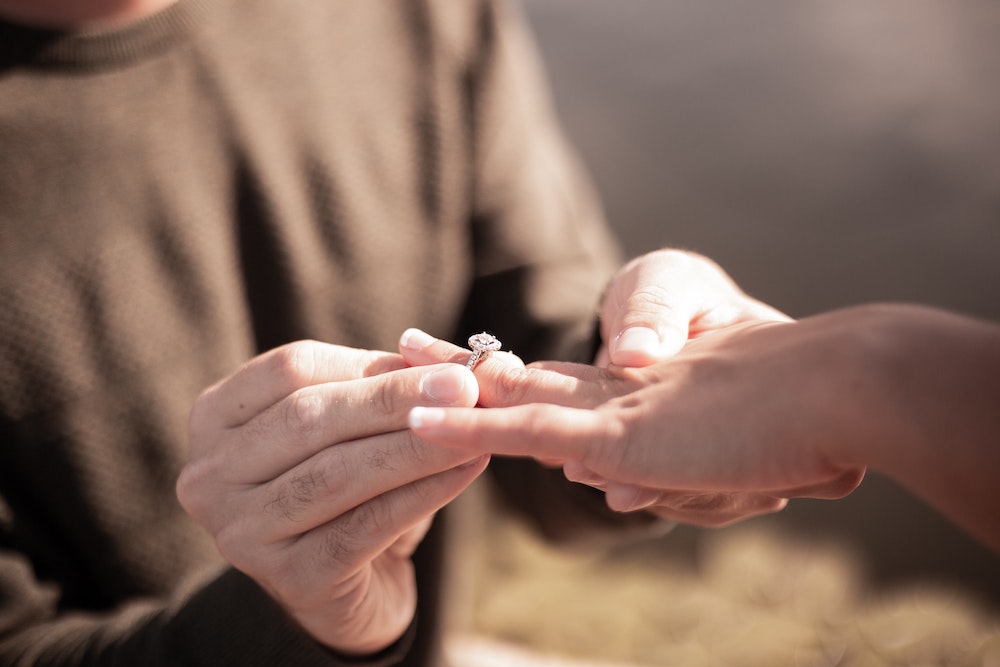Did you know that engagement rings date back to Ancient Rome?
Engagement rings signify a big step in any relationship. It's a tangible commitment showing your significant other that you want to spend the rest of your life with them. And this is a practice that dates back to Ancient Roman times. Of course, throughout history, trends and fads will change to keep up with the times—and this is the case for engagement rings, too.
Journey with us as we take a glance back at the history behind these jewelry-gifting proposals and how the styles have changed over the years.
Ancient Rome

Roman ring | Courtesy of Ancient Origins
Engagement rings weren't always diamonds. In fact, in Ancient Rome, women were typically given rings made of ivory, bone, copper, or other similar materials "to signify a business contract or to affirm mutual love and obedience," according to the Gemological Institute of America (GIA). (Also, can we just—"business contract"? How romantic.)
By the 2nd century CE, gold became the metal of choice for rings—something that has carried on for centuries since. Many rings had clasped hands engraved on them, as well.
850 AD
But it wasn't until 850 AD that engagement rings symbolized a marriage proposal. This was started by Pope Nicholas I who put forth that an engagement ring signified a man's intent to marry. The ring itself was to symbolize a "financial sacrifice" made by the man, with gold continuing to be the go-to style for rings.
1477
However, in 1477, diamonds first got incorporated into engagement rings—a standard nowadays. According to GIA, Archduke Maximilian of Austria asked for Mary of Burgundy's hand in marriage with a ring that had diamonds mounted on it in the shape of an "M." Aww.
1500s

A Gimmal ring with the hoop opened | by user:geni via Commons Wikimedia
Gimmel rings were all the rage during this time and were made with two or three hoops that then fit together to form a single ring. Once a couple became engaged, the bride- and groom-to-be would each wear one of the rings, then at the wedding ceremony, the rings would come together as one ring for the bride to wear. Again, gold rings were the standard.
1600s
This is when styles and fads began changing for engagement rings, with more personal designs getting integrated into the structures. As mentioned fairly often in William Shakespeare's plays, silver posy rings were among the most popular during this era. Engravings were cut on the inside of the ring, usually with a love poem or ballad. And in some cases, those silver posy rings would be exchanged for gold ones at the ceremony.
"Is this a prologue, or the posy of a ring?" –Act III, Scene 2 of Hamlet
But by the mid-17th century, the Puritans attempted to end the tradition of wedding rings, as they believe it "endorsed its association with the clergy, church ritual and the irreligious and unconverted individual," says GIA. Obviously, that tradition still remains.
1930s–1940s
Platinum was typically the metal of choice for engagement rings, that is until World War II hit. Then yellow gold came in and was widely used for ring settings and bands. This is also when styles became more simplified—a less-is-more mentality—and intricate designs were added to make up for the smaller stones.
In the 1940s, the tradition of the double-ring began, in which grooms also wore a wedding ring, not just the bride, following the ceremony. It's been estimated that this tradition jumped from 15% to 85% during the 1940s.
Also, thanks to Hollywood and the glitz and glam that came with it, the infamous "A diamond is forever" campaign launched by DeBeers. Diamond engagement rings were very popular and often seen worn by stars, both on- and off-screen.
1953
When John F. Kennedy and Jackie Kennedy got engaged, all eyes were on the engagement ring—an emerald cut diamond and an emerald stone ring set together with a leaf-shaped set of, yes, more diamonds. The popularity of the emerald cut saw a rise in the 1950s because of this.
1975
Matching sets for the bride and groom became very common, with jewelers often selling a matching wedding band set to go with an engagement ring and band for the groom.
2000s and Beyond
While clear diamonds are still relatively popular, many couples are opting for colored diamonds instead. One prominent example of this change can be seen in the blue sapphire engagement ring that Prince William proposed to Kate Middleton—the same ring as worn famously by Princess Diana in the 1980s. There's also been a trend in grooms wearing what they call "man-gagement" rings alongside the bride.
Any other pieces of engagement ring history that we missed? What's your favorite style when it comes to rings and other jewelry? Comment below.
